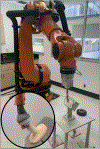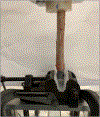Reverse total shoulder arthroplasty with proximal bone loss: a biomechanical comparison of partially vs. fully cemented humeral stems
- PMID: 38417733
- PMCID: PMC11330736
- DOI: 10.1016/j.jse.2024.01.022
Reverse total shoulder arthroplasty with proximal bone loss: a biomechanical comparison of partially vs. fully cemented humeral stems
Abstract
Background: The appropriate amount of cementation at the time of reverse total shoulder arthroplasty with significant proximal bone loss or resection is unknown. Extensive cementation of a humeral prosthesis makes eventual revision arthroplasty more challenging, increasing the risk of periprosthetic fracture. We analyzed the degree of subsidence and torque tolerance of humeral components undergoing standard cementation technique vs. our reduced polymethyl methacrylate (PMMA) protocol. Reduced cementation may provide sufficient biomechanical stability to resist physiologically relevant loads, while still permitting a clinically attainable torque for debonding the prosthesis.
Methods: A total of 12 cadaveric humeri (6 matched pairs) underwent resection of 5 cm of bone distal to the greater tuberosity. Each pair of humeri underwent standard humeral arthroplasty preparation followed by either cementation using a 1.5-cm PMMA sphere at a location 3 cm inferior to the porous coating or standard full stem cementation. A 6-degree-of-freedom robot was used to perform all testing. Each humeral sample underwent 200 cycles of abduction, adduction, and forward elevation while being subjected to a physiologic compression force. Next, the samples were fixed in place and subjected to an increasing torque until implant-cement separation or failure occurred. Paired t tests were used to compare mean implant subsidence vs. a predetermined 5-mm threshold, as well as removal torque in matched samples.
Results: Fully and partially cemented implants subsided 0.49 mm (95% CI 0.23-0.76 mm) and 1.85 mm (95% CI 0.41-3.29 mm), respectively, which were significantly less than the predetermined 5-mm threshold (P < .001 and P < .01, respectively). Removal torque between fully cemented stems was 45.22 Nm (95% CI 21.86-68.57 Nm), vs. 9.26 Nm (95% CI 2.59-15.93 Nm) for partially cemented samples (P = .021). Every fully cemented humerus fractured during implant removal vs. only 1 in the reduced-cementation group. The mean donor age in our study was 76 years (range, 65-80 years). Only 1 matched pair of humeri belonged to a female donor with comorbid osteoporosis. The fractured humerus in the partially cemented group belonged to that donor.
Conclusion: Partially and fully cemented humeral prostheses had subsidence that was significantly less than 5 mm. Partially cemented stems required less removal torque for debonding of the component from the cement mantle. In all cases, removal of fully cemented stems resulted in humeral fracture. Reduced cementation of humeral prostheses may provide both sufficient biomechanical stability and ease of future component removal.
Keywords: Reverse total shoulder arthroplasty; bone cement; humeral stems; implant subsidence; proximal humerus fracture; shoulder biomechanics.
Copyright © 2024 Journal of Shoulder and Elbow Surgery Board of Trustees. Published by Elsevier Inc. All rights reserved.
Figures





Similar articles
-
Cemented vs. press-fit humeral stems: a matched cohort analysis at a mean follow-up of 10 years.J Shoulder Elbow Surg. 2024 Aug;33(8):1755-1761. doi: 10.1016/j.jse.2023.11.029. Epub 2024 Jan 17. J Shoulder Elbow Surg. 2024. PMID: 38242528
-
Long-term outcomes of cemented versus cementless humeral components in arthroplasty of the shoulder: a propensity score-matched analysis.Bone Joint J. 2017 May;99-B(5):666-673. doi: 10.1302/0301-620X.99B5.BJJ-2016-0910.R1. Bone Joint J. 2017. PMID: 28455477
-
Cement-within-cement technique in revision reverse shoulder arthroplasty.J Shoulder Elbow Surg. 2017 Aug;26(8):1448-1453. doi: 10.1016/j.jse.2017.01.013. Epub 2017 Feb 21. J Shoulder Elbow Surg. 2017. PMID: 28233712
-
Cemented humeral stem versus press-fit humeral stem in total shoulder arthroplasty: a systematic review and meta-analysis.Bone Joint J. 2019 Sep;101-B(9):1107-1114. doi: 10.1302/0301-620X.101B9.BJJ-2018-1369.R1. Bone Joint J. 2019. PMID: 31474140
-
Revision of humeral components in shoulder arthroplasty.Bull Hosp Jt Dis (2013). 2013;71 Suppl 2:77-81. Bull Hosp Jt Dis (2013). 2013. PMID: 24328586 Review.

